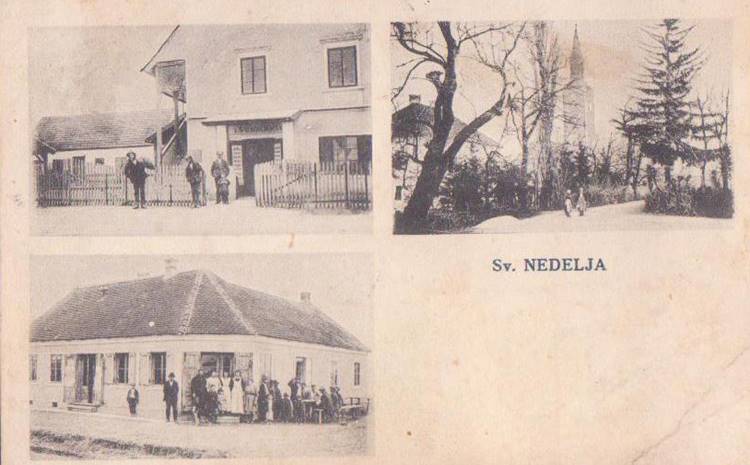Interesting historical facts
Learn a little bit more about the past.

The legend of the origin of the parish Church of the Most Holy Trinity in Sveta Nedelja
Legend has it that the Sava once overflowed its banks and ran right through Sveta Nedelja, and when it retracted into the lake under the hill, a statue of the Holy Trinity was found. The locals interpreted this to be the voice of God, telling them to build a church at that site, and to house the statue within it.
Roman fibula from the 2nd and 3rd century.
Proof of inhabitation in this area extends back to the Roman era. The main road of the Roman Pannonian province ran through this area, connecting Emona (Ljubljana) and Siscia (Sisak), and by the road, in present day Jagnjić Dol, a valuable bronze Roman fibula was uncovered at the Herešinec archaeological site, and dating back to the turn of the 3rd century AD.
The Roman fibula is on display at the Samobor Museum.
Antique tombstone monument to Pontius
The stone tombstone to the Roman official "Pontius", dating to the 3rd century AD, was found near Kerestinec in the late 19th century. Since 1896, the stone monument has been kept at the Archaeological Museum in Zagreb, while a replica is on display in the centre of Kerestinec.
The monument is very interesting, due to its rustic style, and it is thought to have been carved by a local master, and installed near the road in Kerestinec that connected Emona (Ljubljana) and Siscia (Sisak).
Gliding school in Sveta Nedelja
In 1942 and 1943, a military gliding school was operational in Sveta Nedelja. Model competitions and the old landing strip were found at two locations: on the meadow in Sveta Nedelja near the parish Church of the Most Holy Trinity and in Jagnjić Dol, where a wooden hangar was erected in 1942, with a wooden hangar for gliders.
Narrow trail railway - Samoborček
A narrow-track railway, popularly called the Samoborček, ran through Sveta Nedelja from 1901 to 1979. The railway ran from Zagreb, via Podsused to Sveta Nedelja, and further to Samobor and Bregana. The Samoborček was very important for the development of the Sveta Nedelja area, and it was operational until 1979, when it was replaced with road transport.
Battle at Kerestinec - Peasant's revolt
According to the historical chronicles, in 1573, the Peasant's Revolt also spilled into the Sveta Nedelja area, particularly in the areas of Kerestinec and Stupnik. Under the leadership of Ivan Pasanac, a large contingent of the peasant's army arrived in Kerestinec on 3 February 1573, and were quickly joined by massive numbers of peasants from the surrounding settlements. It did not take long for the strong noblemen's army to arrive at the scene, led by Gašpar Alapić.
The decisive battle was held at Kerestinec on 6 February 1573, when the well-trained noblemen's army crushed the revolt, dispersing more than 2000 peasants. The records state that 400 to 500 peasants were killed in the battle, and that the Erdödy castle was damaged.
Mihalj Šilobod Bolšić
One of the most prominent men in Sveta Nedelja history was certainly parish priest of the Sveta Nedelja parish, Mihalj Šilobod Bolšić, who served in the parish of the Most Holy Trinity for 26 years (1760 to 1787). He is best known as the creator of the first Croatian arithmetic (Aritmetika Horvatzka), published in 1758 in Zagreb in the Kajkavian dialect.
During his service in the Sveta Nedelja parish, he issued theoretical instructions for choir singing, entitled "Fundamentum cantus gregoriani seu scolaris".
Mihalj Šilobod Bolšić organised the refurbishment of the sanctuary in the parish Church of the Most Holy Trinity, and the addition of the lower section of the church, nave with choir and new bell tower, which was constructed from 1783 to 1786. He died on 8 April 1787 in Sveta Nedelja.
Rafters on the Sava River
The Sava River was also important for the life of the people living along its banks.
During strong rains in spring and autumn, the Sava would flood the broader area, including the settlements. During strong floods, the waters would carry numerous items downstream, which the people of the lower courses would collect during calmer waters, mostly wood, as the people in the upper Sava areas primarily worked in forestry.
As such, the Sava River would transport wooden logs and beams from Slovenia. When the rafters collected a sufficient number of logs or beams, they would built themselves a raft, which served for the transport of goods along the Sava River.
Trade was conducted in various ways, both with payment in money and with the exchange of goods. When the raft passed through a larger town, customers would come by boat to meet the rafts where they would purchase their goods, while for larger purchases, the raft would dock on the shore.
One of the most important trading points for the Sveta Nedelja rafters was near Podsused near the iron bridge, where the rafter could stop and conduct the majority of his trade there. A ferry raft was also made here.






